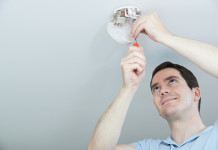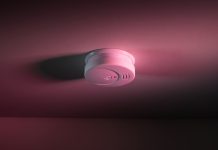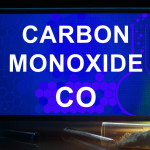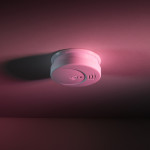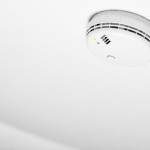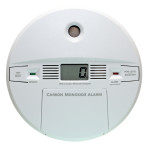A common byproduct of combustion, carbon monoxide (CO) is a poisonous gas that has proven itself to be a danger to RVers. Because carbon monoxide is a byproduct of incomplete combustion, health problems can occur in homes as well as vehicles - by a malfunctioning residential furnace, an automotive exhaust system, or an unvented or faulty gas stove or furnace. Combustion that is not properly ventilated can result in illness or death caused by excessive exposure to CO.
Over the past few years, a number of cases of CO poisoning have occurred in the RV community, many with results. Take, for example, the case of four motorhoming friends who were spending a weekend Southern California mountains. The weather cold, so they kept the generator running to power an auxiliary electric heater. Exhaust fumes and CO accumulated to tunnel the fumes away from the coach.
Frequently referred to as the silent killer, CO works in err insidious manner. Being virtually undetectable by human senses, the gas accumulates; in enclosed places and gives no warning. It can invade while the victims are asleep, but by its very nature, CO also puts conscious people into a sleep from which they never awaken.
Physiologically, the gas prevents the hemoglobin in blood from delivering oxygen to the cells of the body Lack of oxygen slowly weakens the body and in gradual unconsciousness. By the time the victim realizes there is a problem, he or she may be too weak to open a door or a window, or to move outside to fresh air. Without oxygen, the body dies.
Symptoms of CO poisoning run the gamut from having a slight headache to falling into a coma and dying, with such conditions as nausea, weakness, vomiting, drowsiness and heart palpitations in between. People who have pre-existing respiratory or cardiac conditions are especially vulnerable. The heart is particularly targeted, and CO-related heart attacks are common among victims.
Statistical reports vary, but they indicate that each year between 5000 and 10,000 people may die from CO poisoning. According to some sources, approximately 200,000 people experience CO-induced heart attacks, and somewhere around 25 million people suffer ailments caused by CO poisoning that are misdiagnosed as flu, motion sickness, food poisoning or some other illness.
One of the grave characteristics of CO poisoning is that the condition is cumulative. Low doses will accumulate in the body and gradually build up until a problem exists. Even after the victim is removed from the poisonous environment and allowed to breathe fresh air, purging the system of excess CO takes much longer than it took for the CO to invade the body.
Considering the lethal nature of the gas, a good CO detector is easily as important to the safety of occupants as a smoke alarm or a propane detector. Current aftermarket monitors are of small modular design, and they can be installed unobtrusively. Installation should be on a wall at about adult eye level. This is because CO has the same density as air, so it circulates freely throughout the interior atmosphere. CO is effectively detected if the monitor is positioned about 5 feet above the floor.
As we surveyed the CO monitors on the market today, we found significant differences between them. Some are powered by a 9-volt battery, while others are wired into the coach’s 12-volt DC electrical system. Some have sensors that require replacement each year, while others are rated for up to 10 years of life. Some are calibrated to sound the alarm at lower levels of CO than others. Some sound the alarm whenever the preset level of CO is detected, while others work on a time-weighted averaging system, in which the level of CO is calculated along with the length of time the gas is present in the atmosphere to determine if the condition is merely an insignificant momentary rise in CO level or if it is worthy of an alarm. Some are simple stand-alone alarms, while others can be interfaced with existing on-board security systems.
In addition to differences in the hardware, we discovered that manufacturers report differently on the amount of physiological impairment inflicted by varying concentrations of CO in the air, based upon their interpretations of the scientific data available to them. At one end of the scale are claims that 200 ppm (parts per million) of CO will result in a slight headache if it is inhaled for two to three hours. However, a chart from another manufacturer indicates that inhaling 200 ppm for a three-hour period will result in drowsiness, which is three notches up from “slight headache.” This same chart reveals that breathing 200 ppm of CO for as little as 60 minutes would actually produce a slight headache, which is the lowest detectable level of physical discomfort or impairment resulting from CO exposure.
Depending upon the type and size of RV in question, either one or two detectors should be installed. The deciding factor is whether or not there is an enclosed sleeping area that is separate from the main living area. If the separate sleeping area is located where exhaust fumes from a gas appliance Dr a generator normally accumulate, a second monitor its recommended for installation in that area.
It is possible that excessive CO may not necessarily be coming from your own RV. If you are parked in a campground surrounded by several other units, exhaust fumes from their engines, appliances and generators may raise the CO level in the area enough to adversely affect you, especially if the prevailing breeze carries the fumes in your direction.
This brings us to a few rules that will help you avoid exposure to excessive amounts of CO. Of course, the first rule is to have at least one or more onboard CO detectors to alert you to the presence of the dangerous gas. Then make sure each detector is functional.
Before You Travel
Have your own vehicle engine and generator inspected to ensure that the exhaust systems are sound. If there are exhaust leaks, have the offending system repaired before taking another trip.
Make sure the tip of the exhaust pipe for the generator extends well beyond the outer wall of the living quarters. CO floats freely in the air, so it can invade from below if expelled under the floor. The most efficient exhaust systems have the fewest bends, creating low back pressure. If the exhaust system has ever been damaged, resulting in a bend or a kink, it should be replaced. Make sure the exhaust system does not utilize flexible tubing, because it is not leak-free.
Inspect propane-burning appliances to ensure that combustion is as efficient as possible. Flames should burn bright blue. If not, repairs are in order. Yellow or reddish flames are an indicator of inefficient combustion, which results in higher levels of CO.
Make sure the furnace exhaust system is unobstructed and that it is well sealed off from the interior of the coach.
Inspect the floor and walls of the coach, looking for any opening that would allow fumes to enter from outside. Holes that were made to accommodate the passage of plumbing or electrical lines from the interior to the exterior should be well sealed.
While You Travel
Partial vacuum (low pressure) is created in a vehicle moving at speed and will naturally tend to make dust and exhaust fumes enter. That’s why the back of an RV gets so dirty. This same low pressure can draw exhaust fumes inside.
To prevent the problem while traveling, use windows and vents in ways that naturally pressurize the interior with fresh air. Make sure rear windows are tightly closed to prevent fumes from being sucked inside.
When you are in heavy traffic or in tunnels, be aware that you may be affected by CO from other vehicles, including those that are powered by diesel engines. (Some people believe chat diesel engines don’t produce CO, but they do.)
If you begin to notice CO-related symptoms while traveling, pull over and exit the vehicle as soon as possible. Seek medical attention.
In Camp
Close windows located near or above auxiliary generator or furnace/refrigerator/water heater exhaust outlets when these units are operating. Make sure window and door seals are in good condition.
If possible, position the RV in such a manner that the prevailing wind will blow exhaust fumes away, rather than toward your coach. This pertains to your position relative to neighboring RVs, as well as to the position of your own generator-exhaust pipe.
Never park with exhaust pipes or gas-appliance outlets facing toward a wall or a fence chat would contain the exhaust fumes and direct them back toward the coach. Never run the engine, auxiliary generator or gas appliances when parked indoors, as in a storage garage or a service center.
Avoid obstructing the exhaust system of the generator or gas appliances in any way.
Turn on the fan above the stove when using the stove or the oven. Never use the stove or the oven to heat the interior of the coach.
Don’t run the generator at night while you are asleep.
but if you have several family members vying for bandwidth for things like streaming video and playing Overwatch online best wireless routers under 50 a new router can make a world of difference and help keep the peace.
If anyone inside the RV starts to feel a headache or the onset of nausea, get outside into the fresh air as quickly as possible, and ventilate the coach. Medical attention should be sought so proper detoxification procedures can be started.
Like so many potentially hazardous situations, CO poisoning can be prevented. Avoiding this medical problem starts with proper installation and maintenance of exhaust systems, followed up by periodic inspection to make sure there has been no damage or deterioration that would result in exhaust leaks. Make sure the coach body is sealed tightly, especially in the floor area where plumbing and electrical lines penetrate. Then follow the common-sense rules outlined here, beginning with the installation of high quality CO detectors. All of this will be time, money and effort well spent.





















